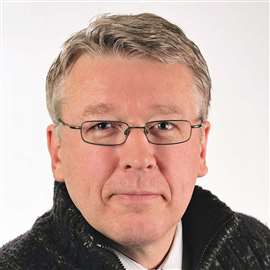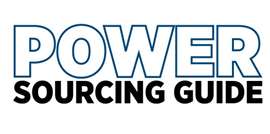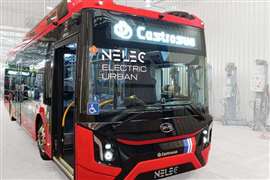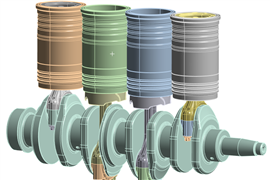Read this article in 中文 Français Deutsch Italiano Português Español
New Holland talks energy ecosystems in ag sustainability
30 November 2024
New Holland Agriculture is investigating alternatives to fossil fuels for powering agricultural machinery, and the broader topic of energy-independent farms.
New Holland Agriculture, part of the CNH Industrial group, has been working for many years to support the shift to clean energy. This included the launch in 2021 of the T6.180 Methane Power, the first commercially available tractor powered by biomethane.
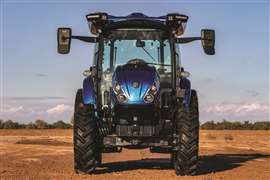 New Holland T4 Electric Power tractor. (Photo: New Holland)
New Holland T4 Electric Power tractor. (Photo: New Holland)
Alessandro Zilli, business manager, Alternative Fuels, New Holland Agriculture, explained that the race for more sustainable power solutions in agricultural applications has three major contenders: hydrogen, battery-electric and gas.
“The key technological challenge for all these fuels is energy density, or rather the capability to reach an almost-equivalent performance and range as diesel fuel,” said Zilli. “For example, to deliver the same potential as a tank of diesel, compressed natural gas (CNG) needs more space; less so for its liquefied form (LNG).”
Energy Ecosystem
“Most importantly though, all these new technologies carry a novel system approach which is radically changing the mindset of the various players,” said Zilli. “In agriculture, this has crystallized into a vision of an entire ecosystem, including decentralized power generation utilizing renewable energy sources such as solar or biomass.”
In this scenario, the tractor is no longer simply a machine for field work, but an integral component in a complex business operation encompassing the entire farm.
“Farmers who are interested in these new technologies have a pretty clear idea of the potential represented by the circular economy and how producing their own fuel can shield them from market price fluctuations.”
Photovoltaics
About €1 billion has been directed at development of advanced agrivoltaics systems. These use photovoltaic panels that are compatible with the cultivated land on which they are positioned, protecting the soil and slowing down water evaporation due to climate change.
“These systems require the farmer to balance their land production with energy harvesting. This new breed of farmers needs to possess advanced agronomic competencies that range from management of a photovoltaic plant to the best ways to manage crops being grown in these changing conditions.
“Farmers who are interested in these new technologies have a pretty clear idea of the potential represented by the circular economy.”
Alessandro Zilli, New Holland Agriculture
“This new approach goes hand in hand with digital transformation and process automation,” said Zilli. “Imagine that agrivoltaic farms will be based on an interconnected system between agriculture and energy production.”
In 2023, New Holland Agriculture announced it would participate in the Agri Solar Demo Farm project. Operated in cooperation with three other companies, Hubfarm, REM Tec and xFarm, this pilot project will set up an energy independent 14-hectare farm in the Mantua province of northern Italy.
Biomethane Potential
The European Union is also championing infrastructure creation for production of biomethane for use in power generation and transportation, although at this point, Italy is behind the curve. According to the European Biogas Association (EBA), there are just 33 plants for biomethane production now operating in the country.
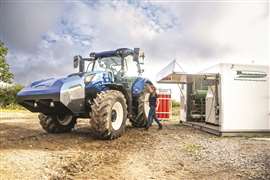 New Holland T6.180 Methane Power Tractor. (Photo: New Holland)
New Holland T6.180 Methane Power Tractor. (Photo: New Holland)
“But [Italy] has a major installed capacity for biogas, with 1,039 plants between 0.5 and 2 MW,” said Zilli. “Public incentives for these plants are coming to an end in 2027, when some could be converted to biomethane.”
Any farm producing its own biomethane will have a vested interest in operating its machines using the same fuel. Zilli said that the T6.180 Methane Power tractor has the same power and torque curve as the T6.180 Diesel.
Instead of a diesel fuel tank, the model has seven gas containers mounted in the central body of the tractor, which can hold up to 185 liters of fuel. A Range Extender option adds more containers at the rear for an additional 270-liter capacity.
According to Zilli, “Biomethane offers a series of benefits, including simplification of the machine layout. There’s no aftertreatment system as with the EU Stage 5 diesel model. Noise and vibration are much lower, as well.”
Farmers looking to produce biomethane can also build their own tanking station. “There are already examples of this within a circular economy, where farmers have recharging stations for both biomethane and electric machines. The power even supports other businesses, including breweries, dairies or restaurants,” said Zilli. “We’re also seeing consortiums establishing biomethane production plants using biomass from a number of local farmers.”
Extended Switch
 Alessandro Zilli, business manager, Alternative Fuels, New Holland Agriculture. (Photo: New Holland)
Alessandro Zilli, business manager, Alternative Fuels, New Holland Agriculture. (Photo: New Holland)
Despite these opportunities, Zilli clearly understands that the agricultural market cannot simply transition to biomethane and electric power. “There will be a switch from fossil diesel to a gradual mix of other technologies, including biomethane, electric, while some activities still use diesel or HVO,” he said.
“HVO [hydrotreated vegetable oil] has the advantage of utilizing the current diesel infrastructure. Also, it has no major technological challenges for use with an internal combustion engine. Currently, the real challenge with HVO is production.”
This is a complex and mixed scenario, but farmers can turn to a number of technology suppliers, associations and cooperatives to help lay the groundwork for the shift to future farming. Zilli is optimistic that developments will bring together a series of alternatives that will ultimately become interconnected with public energy and help to achieve future efficiency goals.
Note: this article originally appeared in the November 2024 issue of Power Progress.
POWER SOURCING GUIDE
The trusted reference and buyer’s guide for 83 years
The original “desktop search engine,” guiding nearly 10,000 users in more than 90 countries it is the primary reference for specifications and details on all the components that go into engine systems.
Visit Now
STAY CONNECTED




Receive the information you need when you need it through our world-leading magazines, newsletters and daily briefings.
CONNECT WITH THE TEAM

